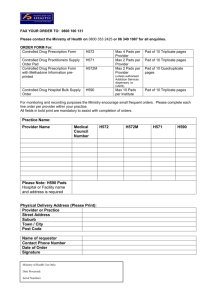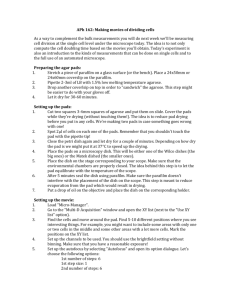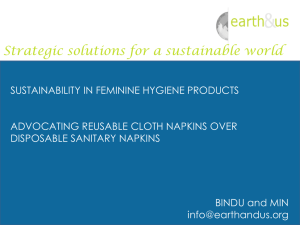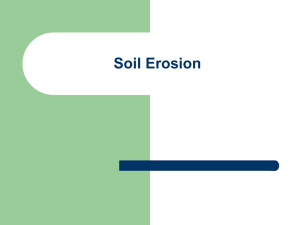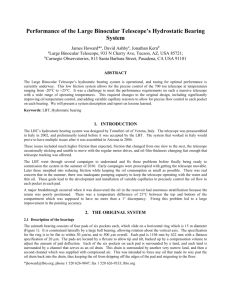Potential Effects of Natural Gas Development on Wildlife Habitat and
advertisement
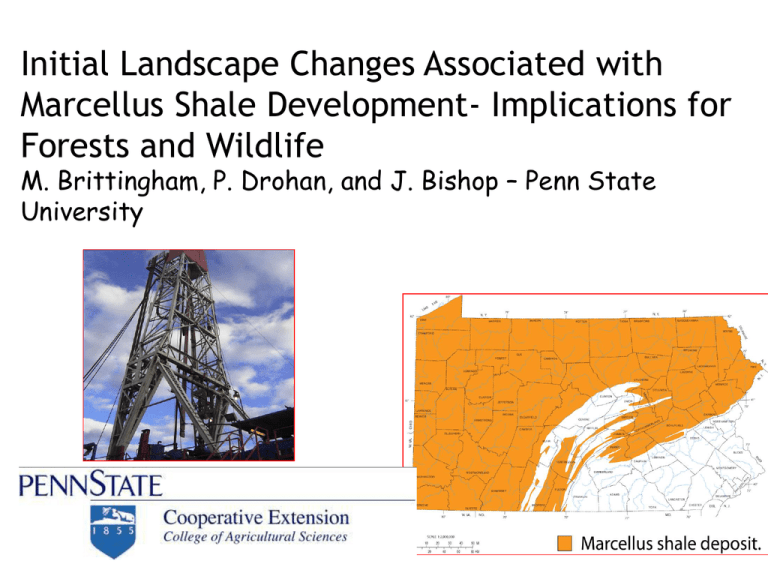
Initial Landscape Changes Associated with Marcellus Shale Development- Implications for Forests and Wildlife M. Brittingham, P. Drohan, and J. Bishop – Penn State University • Patterns of well and pad development • Landscape changes pre and post Marcellus • Implications for forests and wildlife We conducted a GIS analysis using available DEP permit/drilled data, before and after photos, ground truthing, and on the ground measurements to describe landscape change. Our GIS study covers the state. Our field study is focused in a 11 county region in the Northcentral part of the state where forest habitat is most abundant Number of permits and wells drilled increased exponentially and is now slowing down Number of pads is a better indication of landscape change 2500 Variable New Pads Total Pads Number of Pads 2000 1500 1000 500 >2350 pads built 0 2005 2006 2007 2008 Year 2009 2010 2011 Pad location – Public land versus private land 93 % of pads are on to private landand • Available resources manage monitor environmental conditions differ • Size of management unit differs • Bargaining ability differs • Education93% and information needs differ Public Pads n=2353 Private 47 % of pads are in farmland . Highest numbers on private land in the NE and SW part of State 53% of pads are in forest lands with highest numbers in the North Central Regions of State Gas well development changes the landscape Areas are cleared for the well pad Completed pad stabilized with stone Many pads are covered with a protective liner On some pads, impoundments are created to hold water for fracking We measured the pad footprint Well pad footprint and area of local disturbance GIS NAIP photos (n=1081) Mean pad = 1 ha (2.47 acres). Pad+ local disturbance= 2.7 ha (6.7 acres) Range = 0.1- 19 ha (0.25-49.4) Horizontal drilling allows for multiple wells per pad Number of wells per pad n=2,931 wells and 1465 pads Mean = 2.3 wells per pad Noise and Light Pollution associated with pad development and drilling may have local site-specific impacts but probably not long-term effects 70 Compressor (n=4) 65 60 55 50 Completed pad (n=3) 45 40 35 50 Noise (dB) Loudness (dB) Compressors are a longterm source of noise 75 75 70 65 60 55 50 45 40 35 100 50 150 Distance (ft) 100 150 Distance (ft) 200 200 250 250 Tracking proximity of wells to streams is a concern. Smaller streams are generally not mapped 700 Number of pads 600 500 400 300 n=3322, mean=327 m, median=293m 200 100 0 0 240 480 720 960 1200 1440 Distance from pad to nearest mapped stream (m) Pipelines and roads create linear corridors Distance from pad to pre-existing road n=3322, mean=264 m (0.16 miles), median=209 m, Range = 0.02m-2324 m (1.4 miles) 600 Number of pads 500 400 300 200 100 0 0 300 600 900 1200 1500 1800 Distance from pad to pre-existing road (m) 2100 A min of 598 km (371 miles) of new roads have been built to pads and an additional 280 km (174 miles) expected to currently permitted pads Up to 60,000 miles of pipeline are predicted Bradford County Gathering Lines – Johnson et al. 2011 • 1.65 miles ( 2.65 km ) per pad • 10,000 – 25,000 new miles predicted at build out (16,093-40,233 km) Habitat Fragmentation is a result of gas exploration and development and is a primary concern • Change in species composition and abundance (winners and losers) • Spread of invasive species • Disturbance to sensitive habitats • Negative effects on biological diversity and ecosystem functions Pad placement by forest fragmentation classification (n=2221) • Agricultural and open habitat = 48% • Edge forest (within 100 m of preexisting opening or edge) = 25% • Patch forest (woodlots) = 2% Approximately 25% of wells are going into core forest (forest > 100 m from pre-existing opening or edge) For select blocks we mapped the entire infrastructure Fragmentation Index Before =0.753 After pads= 0.681 (-0.072) After mapped = 0.580 (-0.173) Reclamation status for 1283 pads • 84% no reclamation 16% reclaimed • Pad + local disturbance went from 6.7 acres before to 1 acre after • Most reclamation to grassy cover Comparing Effects Shallow Marcellus Electronic Field Guide-http://marcellusfieldguide.org/ http://ee3.cei.vvvvpsu.edu/index.php • Private forest landowners are in need of information on ways to minimize disturbance upfront and on ways to use restoration to achieve landowner management goals • There is a trend toward more wells per pad but currently over 75% have only 1 or 2 wells per pad • Current trends put core forest habitat at risk particularly on private land • Public land will become increasingly important for large blocks of undeveloped habitat and the ecosystem services provided We thank the following organizations for funding support • Heinz Endowments • Marcellus Center for Outreach and Research (MCOR) • PA Game Commission State Wildlife Grants We thank the following individuals for assistance in the field and with database analysis K. Yoder, E. Thomas, N. Fronk, E. Barton, J. Driscoll, C. Fink, M.K. Lupton, M. Marsicano, and K. Medash
